Special Report
Here's When Every State Plans to Lift COVID-19 Restrictions
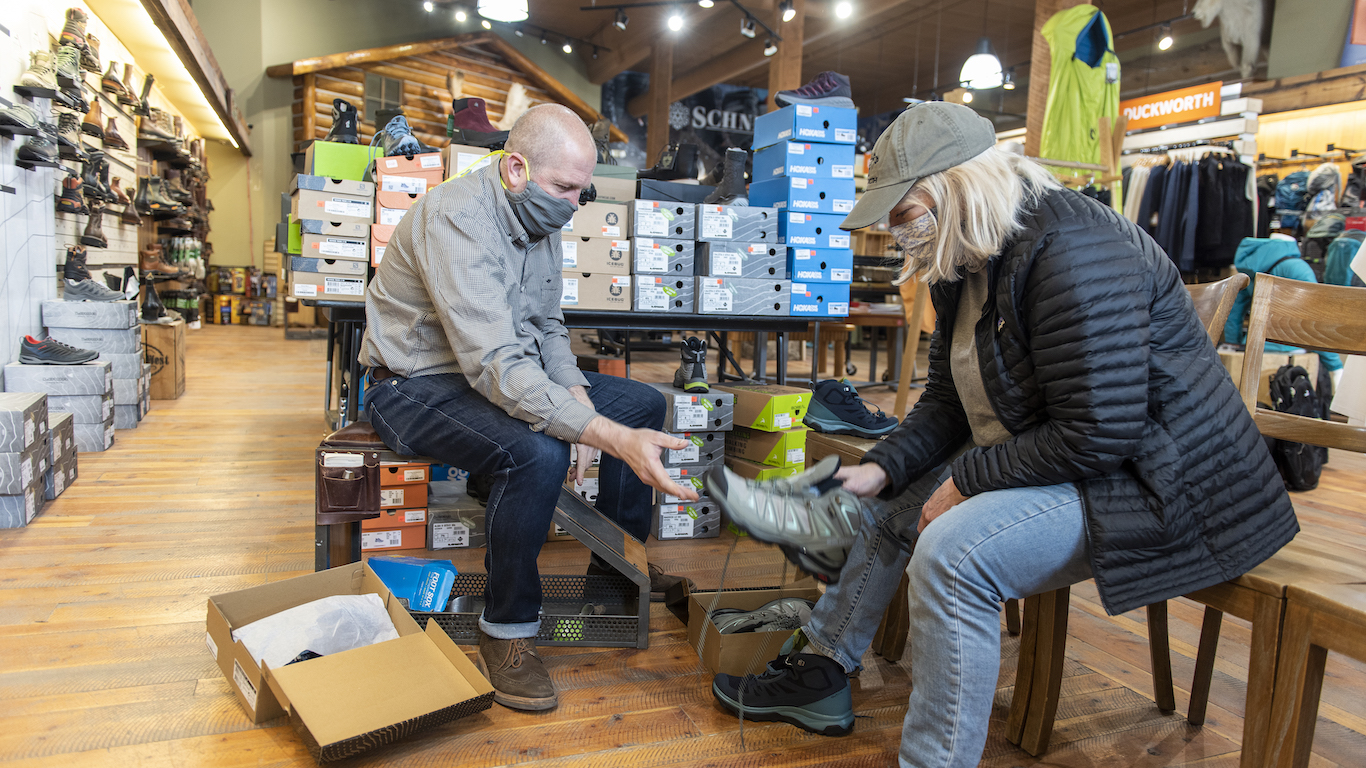
Published:
Last Updated:

On March 19, California became the first state to implement a statewide stay-at-home order. The order banned residents from leaving their home for nonessential reasons in an effort to halt the spread of COVID-19. Since then, 41 other states have followed suit, imposing their own orders and restrictions, ultimately putting more than 300 million Americans under stay-at-home or shelter-in-place orders.
Now, as medical experts believe the numbers of new daily cases of the virus are peaking across much of the country, states are beginning to lift these orders, ease restrictions, and slowly restart their economies. As of May 8, more than half of all states have begun easing shutdown restrictions, and a handful of other states will soon join their ranks.
24/7 Wall St. reviewed state government websites and statements from elected officials to determine when each state plans on lifting stay-at-home orders. Supplemental information on school closings and traveler quarantine rules came from the Kaiser Family Foundation, a nonprofit public health policy think tank.
While medical and public health experts have been studying the coronavirus for months, much remains unknown about the novel coronavirus and COVID-19, the disease the virus causes. Many fear that lifting restrictions and opening businesses too rapidly will lead to a second wave of infections that could eclipse the first.
As a result, while many state governors have chosen a specific date on which to lift stay-at-home orders, they are also acknowledging that these dates could change and that reopening remains contingent on several factors, including testing capacity and long-term declines in hospitalizations. Here is a look at the states where the virus is growing the fastest right now.
Governors and policy makers are eager to lift restrictions because the economic harm resulting from the stay-at-home orders is proving to be catastrophic. The monthly unemployment rate hit 14.7% in April, a level not seen since the Great Depression. Here is a look at every state’s unemployment claims since COVID-19 shut down the economy.
Click here to see when every state plans to reopen after COVID-19 restrictions are lifted
Alabama
> Stay-at-home order: Statewide; implemented April 4, 2020
> Stay-at-home order lifted: April 30, 2020
> Quarantine for travelers (as of May 7): No mandatory restrictions
> School closure status: Closed for the academic year
> COVID-19 cases as of May 5, 2020: 8,437 (172.6 per 100,000 people — 23rd lowest)
> Projected unemployment rate, July 2020: 14.5% (6th lowest)
Alabama Gov. Kay Ivey (R) allowed the state’s stay-at-home order to expire at the end of April. Life will not return to normal in the state immediately after, however, as the governor acknowledged the need for greater testing capacity before all businesses can reopen normally. Currently, retail stores can only operate at 50% capacity.
[in-text-ad]
Alaska
> Stay-at-home order: Statewide; implemented March 28, 2020
> Stay-at-home order lifted: April 24, 2020
> Quarantine for travelers (as of May 7): Mandatory for all travelers
> School closure status: Closed for the academic year
> COVID-19 cases as of May 5, 2020: 371 (50.3 per 100,000 people — 3rd lowest)
> Projected unemployment rate, July 2020: 17.8% (3rd highest)
The stay-at-home order in much of Alaska was lifted on April 24, before the rest of the country. As part of the easing of restrictions, Gov. Mike Dunleavy (R) allowed restaurants to open — and operate at 25% capacity. The lifting of restrictions did not apply to Anchorage until April 27. Starting on May 8, restaurants can operate at 50% capacity, and bars can open and operate at 25% capacity.

Arizona
> Stay-at-home order: Statewide; implemented March 31, 2020
> Stay-at-home order lifted: May 15, 2020
> Quarantine for travelers (as of May 7): Mandatory for travelers from certain states
> School closure status: Closed for the academic year
> COVID-19 cases as of May 5, 2020: 9,305 (129.7 per 100,000 people — 13th lowest)
> Projected unemployment rate, July 2020: 15.4% (24th lowest)
Arizona Gov. Doug Ducey (R) has extended the state’s stay-at-home order until May 15. The order was originally set to expire at the end of April. Despite the extension, retailers will be allowed to open starting May 8 on the condition that customers follow social distancing guidelines.

Arkansas
> Stay-at-home order: None
> Stay-at-home order lifted: N/A
> Quarantine for travelers (as of May 7): No mandatory restrictions
> School closure status: Closed for the academic year
> COVID-19 cases as of May 5, 2020: 3,496 (116.0 per 100,000 people — 10th lowest)
> Projected unemployment rate, July 2020: 15.3% (22nd lowest)
Arkansas is one of only a handful of states to have not issued a stay-at-home order. Still, establishments like restaurants have been closed, except for takeout, and public schools in the state will remain closed for the remainder of the academic year. Salons, barbershops, and hair salons reopened on May 6.
[in-text-ad-2]
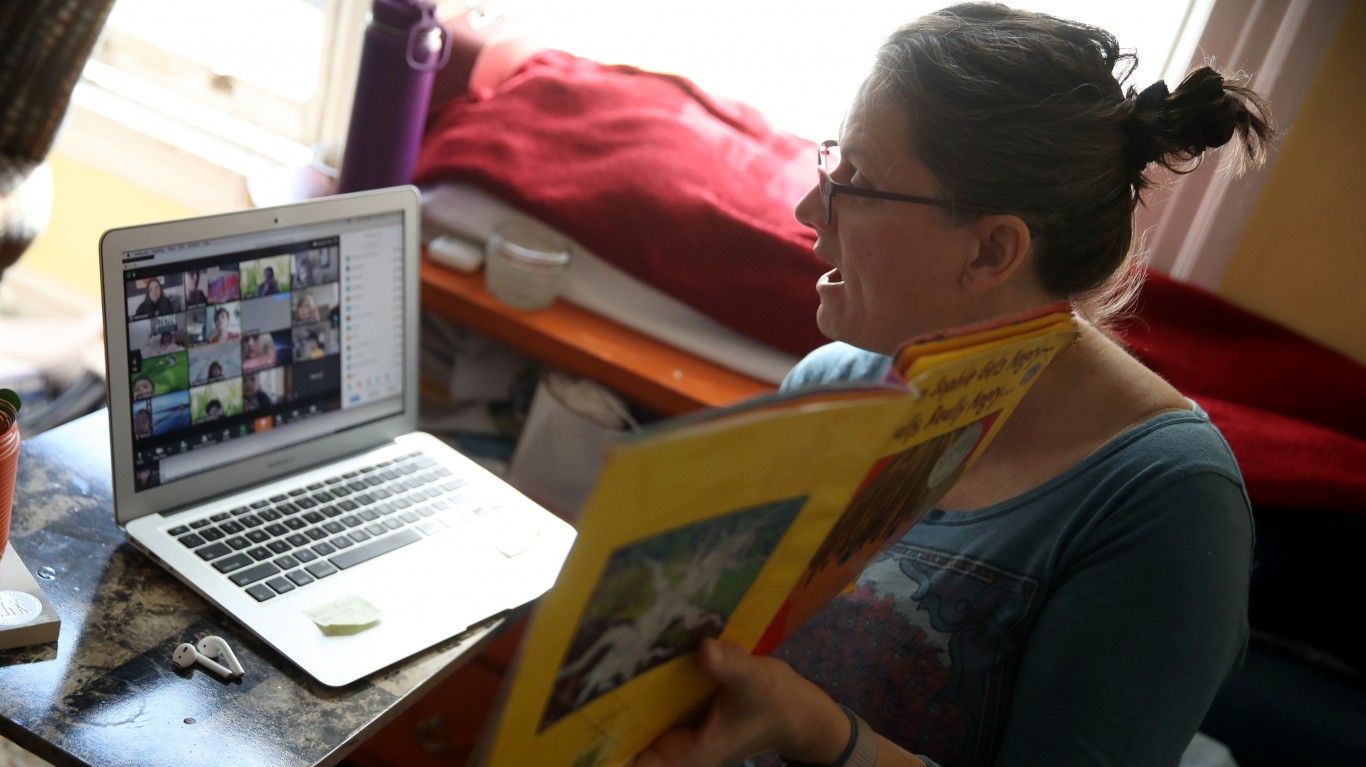
California
> Stay-at-home order: Statewide; implemented March 19, 2020
> Stay-at-home order lifted: N/A
> Quarantine for travelers (as of May 7): No mandatory restrictions
> School closure status: Closure recommended, not mandatory
> COVID-19 cases as of May 5, 2020: 56,705 (143.3 per 100,000 people — 17th lowest)
> Projected unemployment rate, July 2020: 15.6% (19th highest)
California, on March 19, became the first state to issue a stay-at-home order. California is also one of only a handful of states to have not given a specific date as to when it anticipates lifting the order. Gov. Gavin Newsom (D) will coordinate California’s reopening with the governors of Oregon and Washington. The state did partially reopen some parts of the economy on May 8, allowing manufacturers, warehouses, and construction companies, among others, to open.

Colorado
> Stay-at-home order: Statewide; implemented March 26, 2020
> Stay-at-home order lifted: April 27, 2020
> Quarantine for travelers (as of May 7): No mandatory restrictions
> School closure status: Closed for the academic year
> COVID-19 cases as of May 5, 2020: 17,364 (304.9 per 100,000 people — 16th highest)
> Projected unemployment rate, July 2020: 14.1% (4th lowest)
Colorado Gov. Jared Polis (D) issued a stay-at-home order on March 26. On April 27, the order was lifted and replaced with a safer-at-home order. Under the new guidelines, residents are still encouraged to stay home as much as possible, and at-risk populations, such as the elderly, should only leave home when absolutely necessary. Nonessential office work in the state resumed on May 4.
[in-text-ad]

Connecticut
> Stay-at-home order: Statewide; implemented March 23, 2020
> Stay-at-home order lifted: May 20, 2020
> Quarantine for travelers (as of May 7): No mandatory restrictions
> School closure status: Closed for the academic year
> COVID-19 cases as of May 5, 2020: 30,621 (857.1 per 100,000 people — 5th highest)
> Projected unemployment rate, July 2020: 14.8% (10th lowest)
Connecticut Gov. Ned Lamont (D) has pushed the state’s reopening date to May 20. Upon opening, Connecticut will likely implement a procedure of checking temperatures and other signs of infection for individuals before they are permitted to enter certain buildings. Connecticut will coordinate the reopening of its economy with other states in the Northeast, including Massachusetts, New Jersey, New York, and Pennsylvania.
Delaware
> Stay-at-home order: Statewide; implemented March 24, 2020
> Stay-at-home order lifted: May 15, 2020
> Quarantine for travelers (as of May 7): Mandatory for all travelers
> School closure status: Closed for the academic year
> COVID-19 cases as of May 5, 2020: 5,371 (555.3 per 100,000 people — 7th highest)
> Projected unemployment rate, July 2020: 16.8% (6th highest)
Delaware’s stay-at-home order is set to lift on May 15, and Gov. John Carney (D) means to reopen the economy after 28 days of steady declines in confirmed new cases of COVID-19. Once the state reopens, face coverings will be required, and social distancing measures will be implemented.
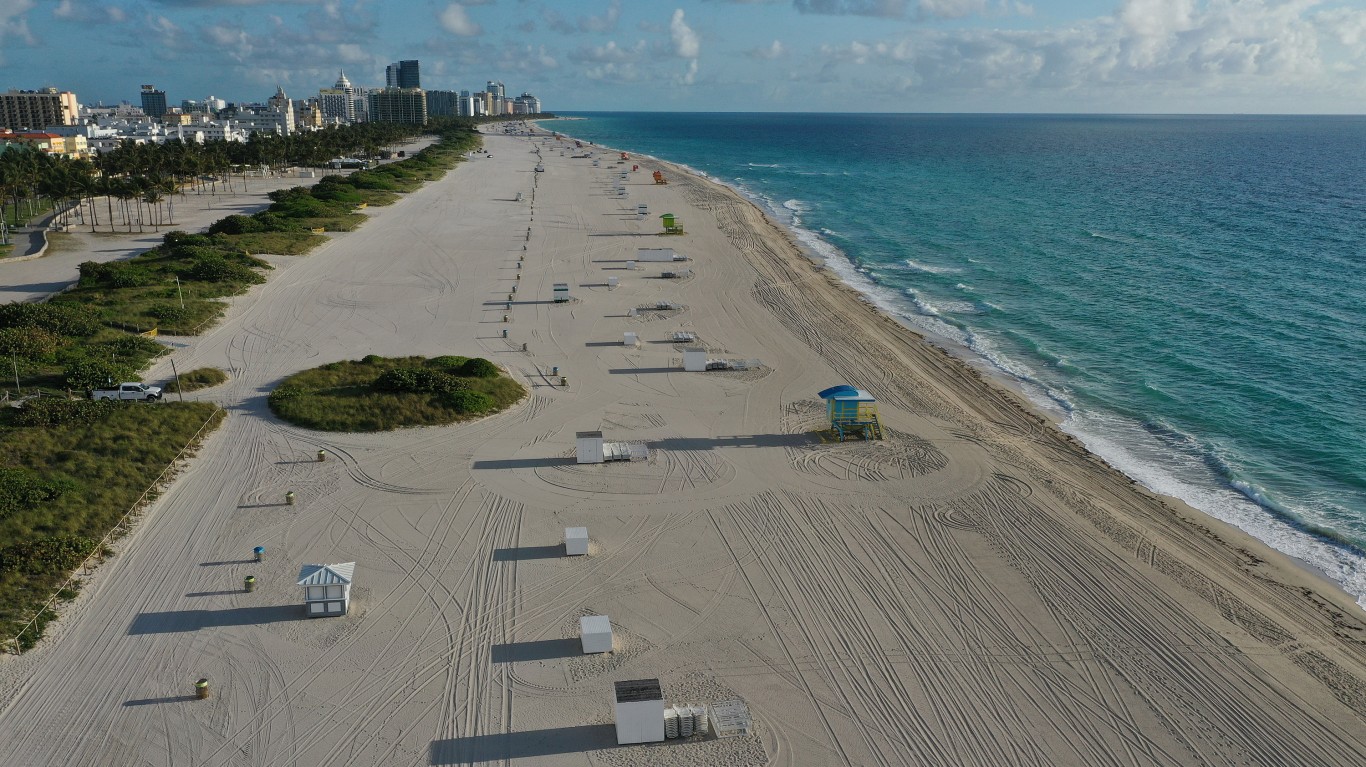
Florida
> Stay-at-home order: Statewide; implemented April 3, 2020
> Stay-at-home order lifted: May 4, 2020
> Quarantine for travelers (as of May 7): Mandatory for travelers from certain states
> School closure status: Closure recommended, not mandatory
> COVID-19 cases as of May 5, 2020: 37,439 (175.8 per 100,000 people — 24th lowest)
> Projected unemployment rate, July 2020: 15.5% (24th highest)
Florida Gov. Ron DeSantis (R) issued a stay-at-home order on April 3, with the caveat that local leaders can decide whether or not to close public beaches. The stay-at-home order expired on May 4, and restaurants and stores are now allowed to operate at 25% capacity. However, visitors will not be allowed in the Florida Keys until June.
[in-text-ad-2]
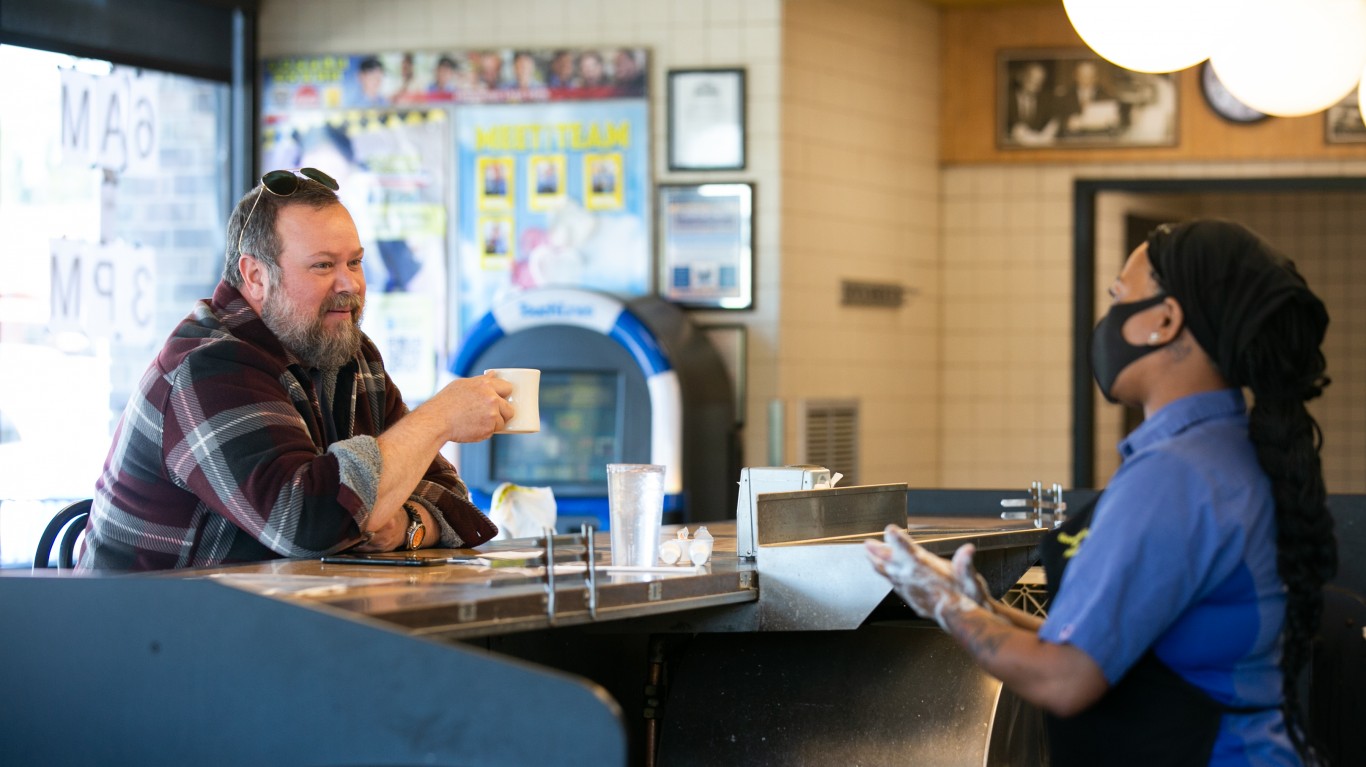
Georgia
> Stay-at-home order: Statewide; implemented April 3, 2020
> Stay-at-home order lifted: April 30, 2020
> Quarantine for travelers (as of May 7): No mandatory restrictions
> School closure status: Closed for the academic year
> COVID-19 cases as of May 5, 2020: 29,852 (283.8 per 100,000 people — 17th highest)
> Projected unemployment rate, July 2020: 14.9% (11th lowest)
Georgia had one of the shortest-lived stay-at-home orders of any state. Restrictions were imposed on April 3, and Gov. Brian Kemp (R) began easing them on April 24 by allowing a range of businesses, including bowling alleys, hair salons, and tattoo parlors, to open for business. Officially, however, the state’s stay-at-home order did not expire until April 30.
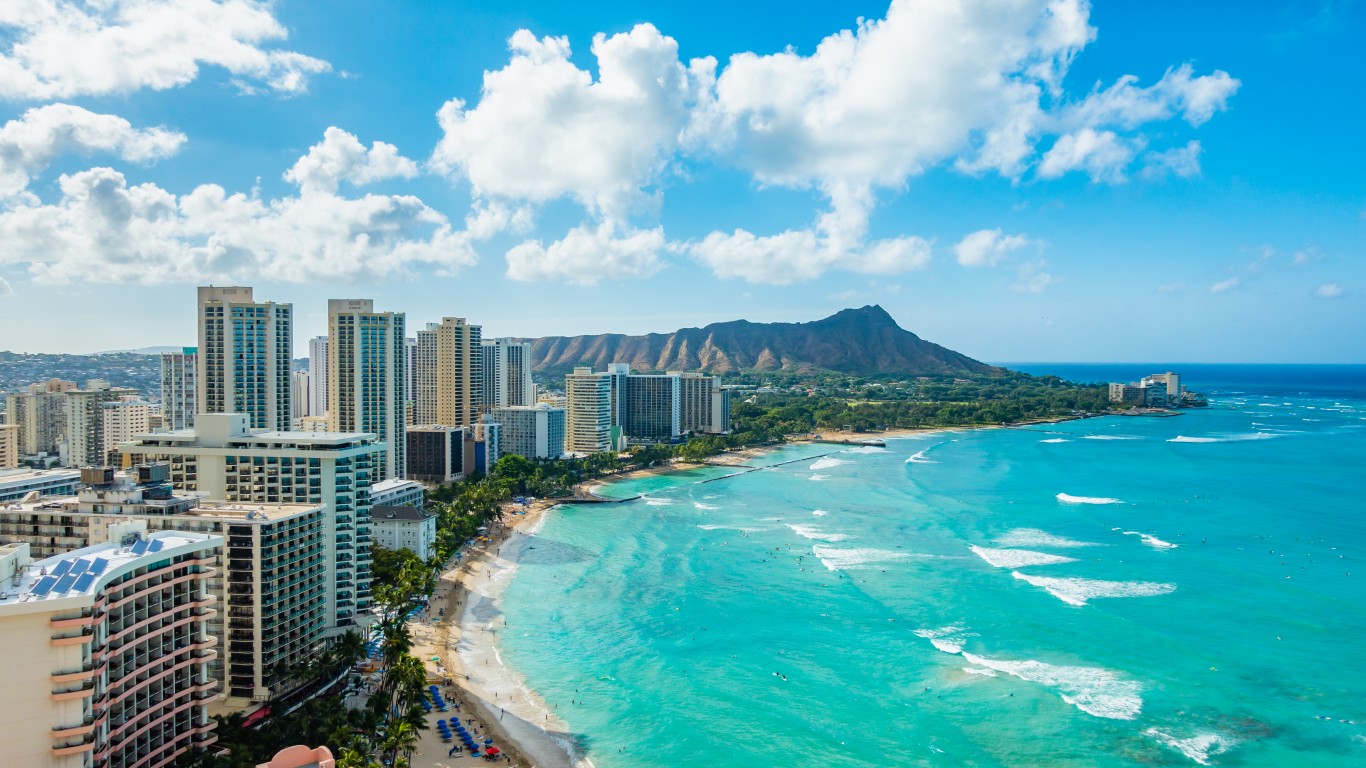
Hawaii
> Stay-at-home order: Statewide; implemented March 25, 2020
> Stay-at-home order lifted: May 31, 2020
> Quarantine for travelers (as of May 7): Mandatory for all travelers
> School closure status: Closed for the academic year
> COVID-19 cases as of May 5, 2020: 625 (44.0 per 100,000 people — 2nd lowest)
> Projected unemployment rate, July 2020: 17.8% (3rd highest)
Hawaii Gov. David Ige (D) implemented a stay-at-home order on March 25, initially scheduled to last until April 30. The order was recently extended, however, and is set to remain in effect until May 31. Still, certain retailers were allowed to reopen starting on May 7.
[in-text-ad]
Idaho
> Stay-at-home order: Statewide; implemented March 25, 2020
> Stay-at-home order lifted: April 30, 2020
> Quarantine for travelers (as of May 7): Mandatory for all travelers
> School closure status: Closure recommended, not mandatory
> COVID-19 cases as of May 5, 2020: 1,960 (111.7 per 100,000 people — 9th lowest)
> Projected unemployment rate, July 2020: 14.0% (3rd lowest)
Idaho Gov. Brad Little (R) first implemented a stay-at-home order on March 25. Initially, the order prohibited businesses from offering curbside pickup or drive-thru services, though this changed in mid-April. So long as there is not a surge in cases of the virus, businesses are set to reopen in stages through May.

Illinois
> Stay-at-home order: Statewide; implemented March 21, 2020
> Stay-at-home order lifted: May 31, 2020
> Quarantine for travelers (as of May 7): No mandatory restrictions
> School closure status: Closed for the academic year
> COVID-19 cases as of May 5, 2020: 65,962 (517.7 per 100,000 people — 8th highest)
> Projected unemployment rate, July 2020: 15.6% (19th highest)
Illinois is one of the hardest hit states by COVID-19 — and the length of its stay-at-home order is a reflection of that fact. The only state to implement a stay-at-home order before Illinois was California. Gov. J.B. Pritzker (D) modified the rules of the order on May 1 to allow greater flexibility where possible. The modifications allow residents to leave their homes for certain types of work and religious services, among other activities deemed necessary.
Indiana
> Stay-at-home order: Statewide; implemented March 24, 2020
> Stay-at-home order lifted: May 4, 2020
> Quarantine for travelers (as of May 7): No mandatory restrictions
> School closure status: Temporarily closed
> COVID-19 cases as of May 5, 2020: 21,033 (314.3 per 100,000 people — 14th highest)
> Projected unemployment rate, July 2020: 15.0% (16th lowest)
In mid-April, Indiana Gov. Eric Holcomb (R) announced that the stay-at-home restrictions in the state will ease starting on May 1. The stay-at-home order expired on May 4, and the state now allows gatherings of as many as 25 people and retailers to operate at 50% capacity.
[in-text-ad-2]
Iowa
> Stay-at-home order: None
> Stay-at-home order lifted: N/A
> Quarantine for travelers (as of May 7): No mandatory restrictions
> School closure status: Closed for the academic year
> COVID-19 cases as of May 5, 2020: 10,111 (320.4 per 100,000 people — 13th highest)
> Projected unemployment rate, July 2020: 14.2% (5th lowest)
Iowa is one of only a handful of states to have not issued a statewide stay-at-home order. Still,
Gov. Kim Reynolds (R) declared a state of emergency in mid-March, closing all nonessential businesses until April 30. Starting May 1, restaurants, gyms, and retailers were allowed to reopen at 50% capacity in 77 of the state’s 99 counties. In the remaining counties, where COVID-19 rates have been higher, nonessential businesses are scheduled to reopen on May 15.

Kansas
> Stay-at-home order: Statewide; implemented March 30, 2020
> Stay-at-home order lifted: May 3, 2020
> Quarantine for travelers (as of May 7): Mandatory for travelers from certain states
> School closure status: Closed for the academic year
> COVID-19 cases as of May 5, 2020: 5,603 (192.4 per 100,000 people — 24th highest)
> Projected unemployment rate, July 2020: 14.7% (8th lowest)
Kansas residents were under a stay-at-home from March 30 through May 3. Beginning May 4, Gov. Laura Kelly (D) allowed restaurants to open at 50% capacity, though places like bars, nightclubs, and casinos have remained closed.
[in-text-ad]

Kentucky
> Stay-at-home order: Statewide; implemented March 26, 2020
> Stay-at-home order lifted: N/A
> Quarantine for travelers (as of May 7): Lifted
> School closure status: Closure recommended, not mandatory
> COVID-19 cases as of May 5, 2020: 5,822 (130.3 per 100,000 people — 14th lowest)
> Projected unemployment rate, July 2020: 16.3% (10th highest)
Kentucky Gov. Andy Beshear (D) plans to restart his state in phases. Though no date has been set for lifting the stay-at-home order, starting May 11, certain businesses, such as construction and auto dealerships, could reopen at 50% capacity.
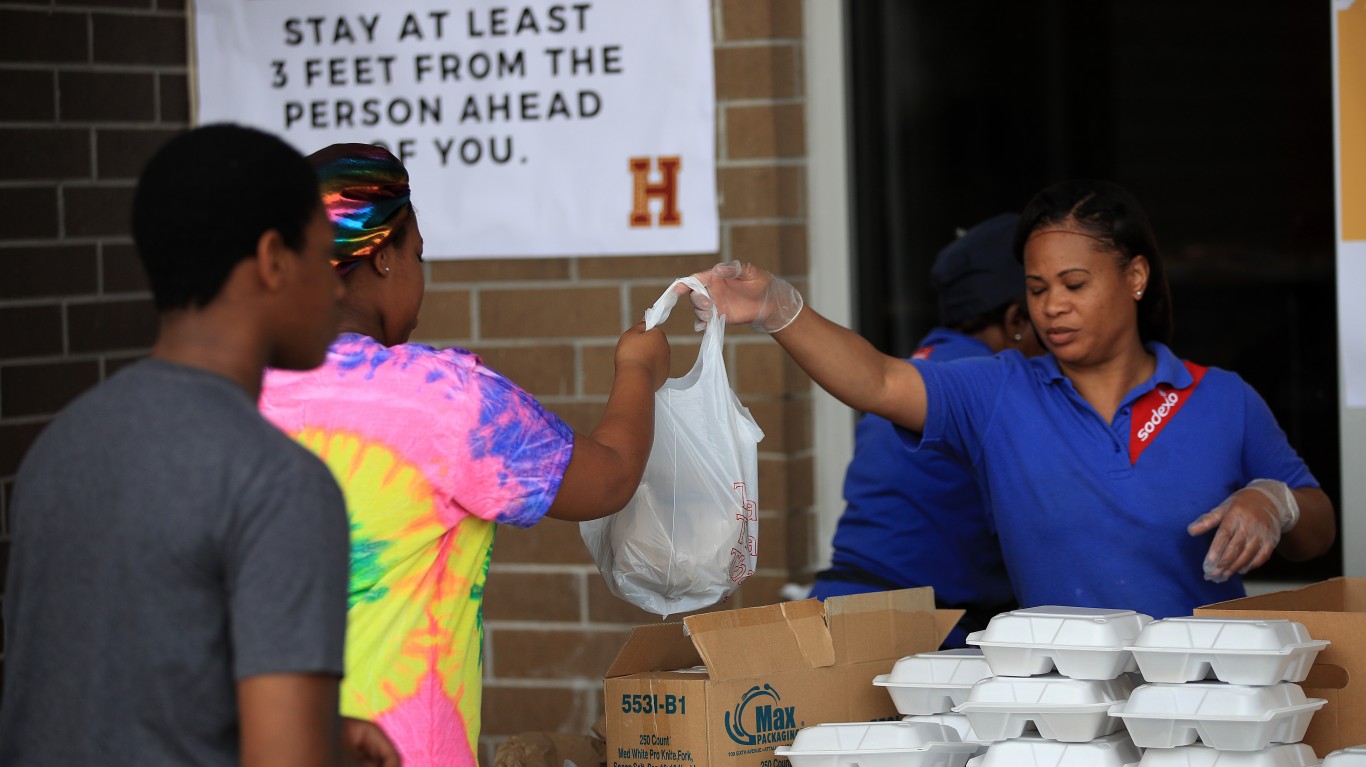
Louisiana
> Stay-at-home order: Statewide; implemented March 23, 2020
> Stay-at-home order lifted: May 15, 2020
> Quarantine for travelers (as of May 7): No mandatory restrictions
> School closure status: Closed for the academic year
> COVID-19 cases as of May 5, 2020: 29,996 (643.7 per 100,000 people — 6th highest)
> Projected unemployment rate, July 2020: 18.0% (2nd highest)
While restaurants now offer pickup and delivery services, and stores can offer curbside pickup, the stay-at-home order remains in effect in Louisiana until at least May 15. Louisiana is one of the hardest hit states by the coronavirus, both in terms of the infection rate and effects on the economy.

Maine
> Stay-at-home order: Statewide; implemented April 2, 2020
> Stay-at-home order lifted: May 31, 2020
> Quarantine for travelers (as of May 7): Mandatory for all travelers
> School closure status: Closure recommended, not mandatory
> COVID-19 cases as of May 5, 2020: 1,150 (85.9 per 100,000 people — 7th lowest)
> Projected unemployment rate, July 2020: 15.7% (17th highest)
Maine Gov. Janet Mills (D) issued a stay-at-home order that was set to expire on April 30. However, the governor recently extended the order to last until May 31.
[in-text-ad-2]

Maryland
> Stay-at-home order: Statewide; implemented March 30, 2020
> Stay-at-home order lifted: N/A
> Quarantine for travelers (as of May 7): Mandatory for all travelers
> School closure status: Closed for the academic year
> COVID-19 cases as of May 5, 2020: 27,117 (448.8 per 100,000 people — 9th highest)
> Projected unemployment rate, July 2020: 13.9% (the lowest)
Maryland Gov. Larry Hogan (R), who implemented a stay-at-home order on March 30, has yet to give a specific date for the state’s reopening. The governor, however, has outlined a plan for reopening that involves slowly reopening businesiness and lifting other restrictions. Starting on May 9, the state is allowing outdoor activities like golfing, biking, and tennis.

Massachusetts
> Stay-at-home order: Statewide; implemented March 24, 2020
> Stay-at-home order lifted: May 18, 2020
> Quarantine for travelers (as of May 7): Mandatory for all travelers
> School closure status: Closed for the academic year
> COVID-19 cases as of May 5, 2020: 70,271 (1018.1 per 100,000 people — 3rd highest)
> Projected unemployment rate, July 2020: 15.1% (18th lowest)
Massachusetts Gov. Charlie Baker (R) shut his state down until May 18. However, reopening may not actually begin on that date as the governor has stated that procedures for tracing, testing, and quarantining will need to be in place before restrictions are meaningfully eased.
[in-text-ad]

Michigan
> Stay-at-home order: Statewide; implemented March 24, 2020
> Stay-at-home order lifted: May 28, 2020
> Quarantine for travelers (as of May 7): No mandatory restrictions
> School closure status: Closed for the academic year
> COVID-19 cases as of May 5, 2020: 44,397 (444.2 per 100,000 people — 10th highest)
> Projected unemployment rate, July 2020: 15.2% (21st lowest)
Michigan Gov. Gretchen Whitmer (D) has received criticism for implementing a too strict stay-at-home order, which originally included banning the use of motorized watercraft and residents going to their summer homes. Whitmer has since relaxed some of the more restrictive measures but extended the state’s stay-at-home order until late-May.
Minnesota
> Stay-at-home order: Statewide; implemented March 27, 2020
> Stay-at-home order lifted: May 18, 2020
> Quarantine for travelers (as of May 7): No mandatory restrictions
> School closure status: Closed for the academic year
> COVID-19 cases as of May 5, 2020: 7,851 (139.9 per 100,000 people — 16th lowest)
> Projected unemployment rate, July 2020: 15.0% (16th lowest)
Minnesota Gov. Tim Walz (D) extended his state’s stay-at-home order, which was set to expire on May 4, until May 18. The governor, however, allowed certain industrial and manufacturing businesses to reopen on April 27, allowing as many as 100,000 people in the state to go back to work.
Mississippi
> Stay-at-home order: Statewide; implemented April 3, 2020
> Stay-at-home order lifted: April 27, 2020
> Quarantine for travelers (as of May 7): No mandatory restrictions
> School closure status: Closed for the academic year
> COVID-19 cases as of May 5, 2020: 8,207 (274.8 per 100,000 people — 18th highest)
> Projected unemployment rate, July 2020: 17.5% (5th highest)
Mississippi had a shelter-in-place order in effect from April 3 through April 27. The state is now under a safer-at-home order, which means only the most vulnerable populations, such as the elderly, are required to stay home. Certain businesses in the state are now allowed to operate at 50% capacity.
[in-text-ad-2]

Missouri
> Stay-at-home order: Statewide; implemented April 6, 2020
> Stay-at-home order lifted: May 3, 2020
> Quarantine for travelers (as of May 7): No mandatory restrictions
> School closure status: Closed for the academic year
> COVID-19 cases as of May 5, 2020: 8,916 (145.5 per 100,000 people — 19th lowest)
> Projected unemployment rate, July 2020: 15.7% (17th highest)
Missouri Gov. Mike Parson (R) has implemented a stay-at-home order on April 6 that expired on May 3. As of May 4, businesses have been allowed to reopen and operate at as much as 25% capacity.

Montana
> Stay-at-home order: Statewide; implemented March 28, 2020
> Stay-at-home order lifted: April 26, 2020
> Quarantine for travelers (as of May 7): Mandatory for all travelers
> School closure status: Rescinded
> COVID-19 cases as of May 5, 2020: 456 (42.9 per 100,000 people — the lowest)
> Projected unemployment rate, July 2020: 16.3% (10th highest)
Montana Gov. Steve Bullock (D) lifted his state’s stay-at-home order on April 26. Certain businesses were allowed to reopen on April 27, so long as social distancing was enforced. Bars and restaurants reopened on May 4, but gyms and movie theaters remain closed.
[in-text-ad]
Nebraska
> Stay-at-home order: None
> Stay-at-home order lifted: N/A
> Quarantine for travelers (as of May 7): No mandatory restrictions
> School closure status: Temporarily closed
> COVID-19 cases as of May 5, 2020: 6,438 (333.7 per 100,000 people — 12th highest)
> Projected unemployment rate, July 2020: 15.1% (18th lowest)
Though Nebraska is one of only a handful of states to not implement a stay-at-home order, it has still restricted economic activity. These restrictions, however, were eased beginning on May 4, and businesses and restaurants in certain parts of the state were allowed to reopen so long as they operate at a limited capacity.

Nevada
> Stay-at-home order: Statewide; implemented April 1, 2020
> Stay-at-home order lifted: May 9, 2020
> Quarantine for travelers (as of May 7): No mandatory restrictions
> School closure status: Closed for the academic year
> COVID-19 cases as of May 5, 2020: 5,630 (185.5 per 100,000 people — 25th highest)
> Projected unemployment rate, July 2020: 19.7% (the highest)
Nevada Gov. Steve Sisolak (D) initially set his state’s stay-at-home order to expire on April 30. Sisolak then extended the order to May 15 but has since said the order will lift on May 9 as Nevada has hit its benchmarks, suggesting it is becoming safer to reopen. When the order lifts, businesses can reopen and operate at a limited capacity.

New Hampshire
> Stay-at-home order: Statewide; implemented March 27, 2020
> Stay-at-home order lifted: May 31, 2020
> Quarantine for travelers (as of May 7): No mandatory restrictions
> School closure status: Closed for the academic year
> COVID-19 cases as of May 5, 2020: 2,636 (194.3 per 100,000 people — 23rd highest)
> Projected unemployment rate, July 2020: 15.0% (16th lowest)
Though New Hampshire Gov. Chris Sununu (R) originally had set the stay-at-home order to expire on May 4, he recently extended the shutdown to last through May. Still, starting May 11, retailers will be allowed to open and operate at 50% capacity, and restaurants can reopen with heavy restrictions on May 18.
[in-text-ad-2]
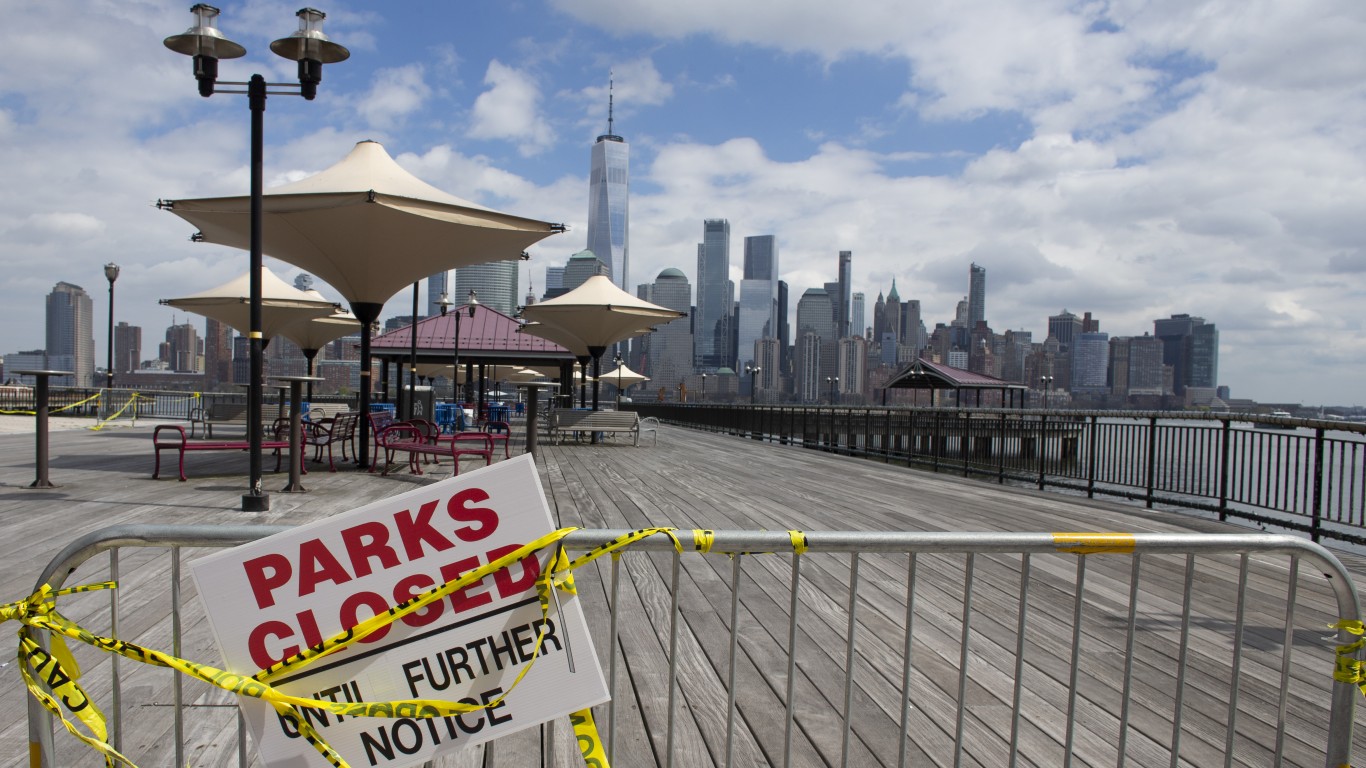
New Jersey
> Stay-at-home order: Statewide; implemented March 21, 2020
> Stay-at-home order lifted: June 5, 2020
> Quarantine for travelers (as of May 7): No mandatory restrictions
> School closure status: Temporarily closed
> COVID-19 cases as of May 5, 2020: 130,593 (1465.9 per 100,000 people — 2nd highest)
> Projected unemployment rate, July 2020: 15.6% (19th highest)
New Jersey Gov. Phil Murphy (D) has set his state’s stay-at-home order to expire on June 5. New Jersey has been one of the hardest hit states by the virus and also has one of the longest standing stay-at-home orders.
New Mexico
> Stay-at-home order: Statewide; implemented March 24, 2020
> Stay-at-home order lifted: May 15, 2020
> Quarantine for travelers (as of May 7): All air travelers
> School closure status: Closed for the academic year
> COVID-19 cases as of May 5, 2020: 4,138 (197.5 per 100,000 people — 22nd highest)
> Projected unemployment rate, July 2020: 16.2% (14th highest)
New Mexico Gov. Michelle Lujan Grisham (D) has set the state’s stay-at-home order to expire on May 15. Lujan Grisham has emphasized that reopening for business will be a gradual process and not happen overnight.
[in-text-ad]
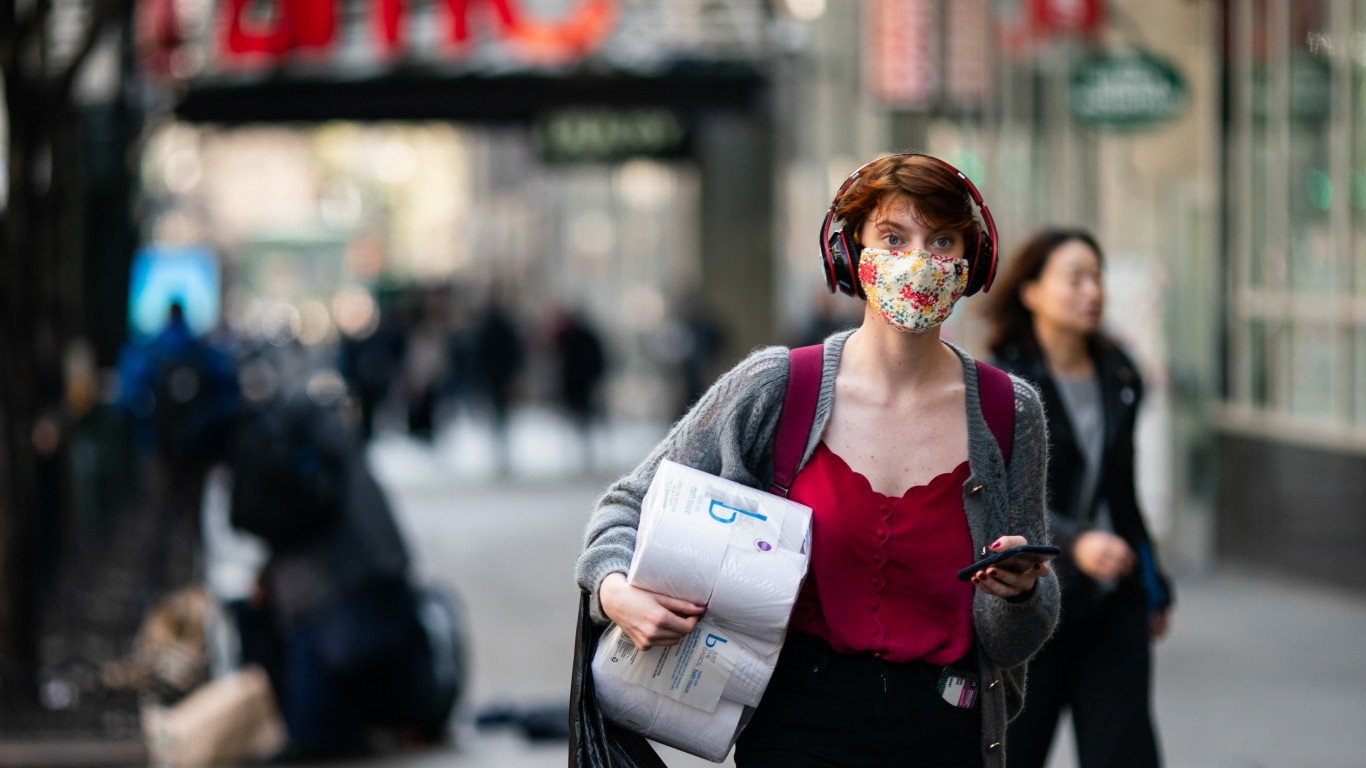
New York
> Stay-at-home order: Statewide; implemented March 22, 2020
> Stay-at-home order lifted: May 15, 2020
> Quarantine for travelers (as of May 7): No mandatory restrictions
> School closure status: Closed for the academic year
> COVID-19 cases as of May 5, 2020: 321,192 (1643.6 per 100,000 people — the highest)
> Projected unemployment rate, July 2020: 16.4% (8th highest)
Although nonessential businesses are set to reopen in New York on May 15, Gov. Andrew Cuomo (D) has indicated that reopening would be contingent on 14 days of falling hospitalization rates. New York is considered to be the epicenter of the coronavirus outbreak in the United States.
North Carolina
> Stay-at-home order: Statewide; implemented March 30, 2020
> Stay-at-home order lifted: May 22, 2020
> Quarantine for travelers (as of May 7): No mandatory restrictions
> School closure status: Temporarily closed
> COVID-19 cases as of May 5, 2020: 12,256 (118.0 per 100,000 people — 12th lowest)
> Projected unemployment rate, July 2020: 15.5% (24th highest)
North Carolina Gov. Roy Cooper (D) has set May 8 as the starting point for the process of reopening the state. Though retail stores may be allowed to reopen on that date, the state’s stay-at-home order is set to remain in effect until May 22.
North Dakota
> Stay-at-home order: None
> Stay-at-home order lifted: N/A
> Quarantine for travelers (as of May 7): Mandatory for all travelers
> School closure status: Temporarily closed
> COVID-19 cases as of May 5, 2020: 1,266 (166.6 per 100,000 people — 21st lowest)
> Projected unemployment rate, July 2020: 15.6% (19th highest)
North Dakota is one of the few states that never ordered residents to remain at home. Though nonessential businesses in the state did close for a period, many were able to reopen and operate at reduced capacity to facilitate social distancing starting on May 1.
[in-text-ad-2]
Ohio
> Stay-at-home order: Statewide; implemented March 23, 2020
> Stay-at-home order lifted: May 29, 2020
> Quarantine for travelers (as of May 7): Mandatory for all travelers
> School closure status: Closed for the academic year
> COVID-19 cases as of May 5, 2020: 20,969 (179.4 per 100,000 people — 25th lowest)
> Projected unemployment rate, July 2020: 16.4% (8th highest)
Ohio Gov. Mike DeWine (R) was expected to lift his state’s stay-at-home order on May 1, but he recently extended the date to May 29. Though the order will remain in place until then, certain businesses will be allowed to reopen throughout the month.
Oklahoma
> Stay-at-home order: None
> Stay-at-home order lifted: N/A
> Quarantine for travelers (as of May 7): Mandatory for travelers from certain states
> School closure status: Closed for the academic year
> COVID-19 cases as of May 5, 2020: 4,127 (104.7 per 100,000 people — 8th lowest)
> Projected unemployment rate, July 2020: 14.7% (8th lowest)
Oklahoma Gov. Kevin Stitt (R) has not implemented a statewide stay-at-home order. Despite the absence of a statewide order, mayors of major cities, including Oklahoma City, Tulsa, and Norman, have issued their own stay-at-home orders.
[in-text-ad]

Oregon
> Stay-at-home order: Statewide; implemented March 23, 2020
> Stay-at-home order lifted: N/A
> Quarantine for travelers (as of May 7): No mandatory restrictions
> School closure status: Closed for the academic year
> COVID-19 cases as of May 5, 2020: 2,817 (67.2 per 100,000 people — 4th lowest)
> Projected unemployment rate, July 2020: 15.5% (24th highest)
Oregon Gov. Kate Brown (D) is one of only a handful of leaders nationwide to not provide an expected expiration date for the stay-at-home order. Brown has indicated that the order will likely be lifted in rural parts of the state before it is lifted in urban areas.
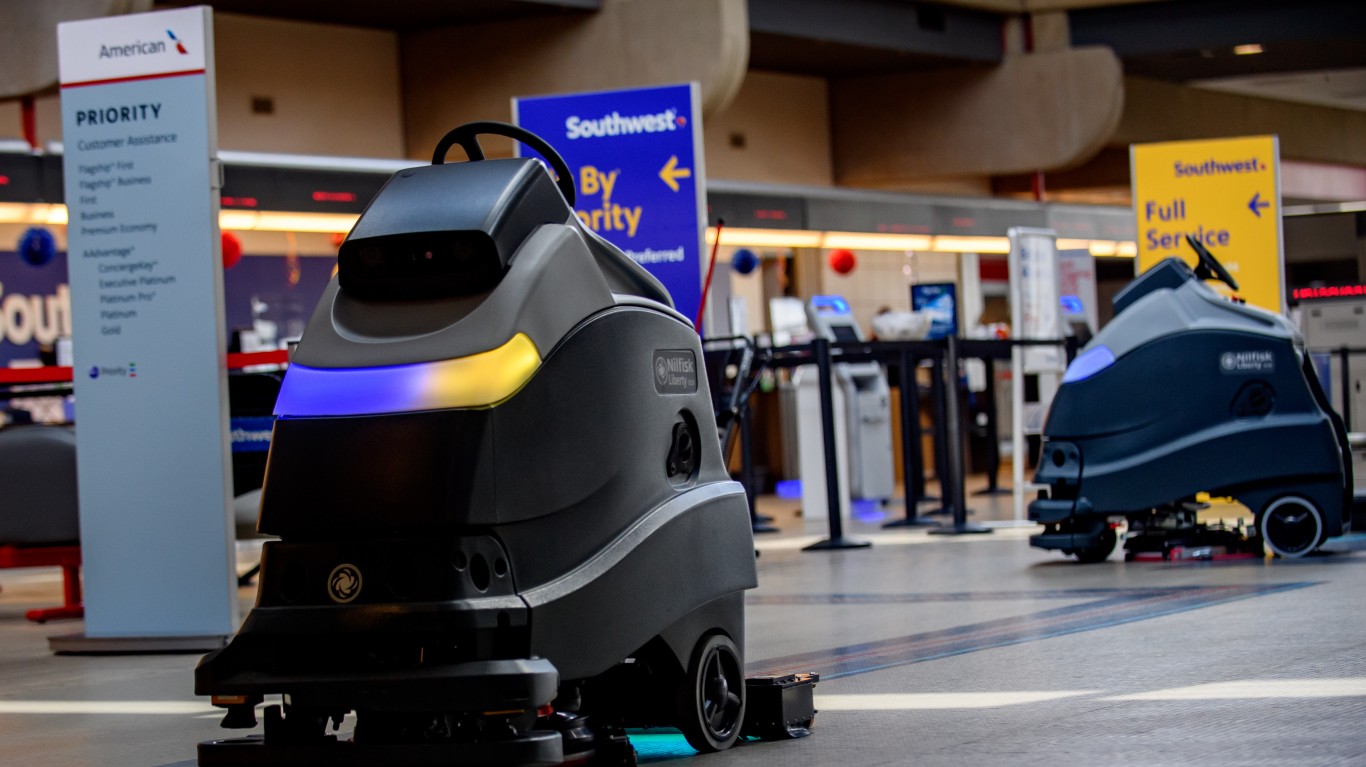
Pennsylvania
> Stay-at-home order: Statewide; implemented April 1, 2020
> Stay-at-home order lifted: May 8, 2020
> Quarantine for travelers (as of May 7): No mandatory restrictions
> School closure status: Closed for the academic year
> COVID-19 cases as of May 5, 2020: 50,957 (397.9 per 100,000 people — 11th highest)
> Projected unemployment rate, July 2020: 16.6% (7th highest)
Gov. Tom Wolf (D) has outlined a three phase plan for reopening Pennsylvania. The first phase, which is set to begin on May 8, will include lifting the stay-at-home order. However, some parts of the state will have to wait weeks longer before they can reopen. Initially, the orders were scheduled to expire on April 30.
Rhode Island
> Stay-at-home order: Statewide; implemented March 28, 2020
> Stay-at-home order lifted: May 8, 2020
> Quarantine for travelers (as of May 7): Mandatory for all travelers
> School closure status: Temporarily closed
> COVID-19 cases as of May 5, 2020: 9,933 (939.5 per 100,000 people — 4th highest)
> Projected unemployment rate, July 2020: 15.4% (24th lowest)
Rhode Island Gov. Gina Raimondo (D) is planning on letting her state’s stay-at-home order expire on May 8, and for the state’s first phase of reopening to begin the following day. The state will be among several others in the Northeast, including New York, New Jersey, Connecticut, and Massachusetts, to coordinate their reopening efforts.
[in-text-ad-2]
South Carolina
> Stay-at-home order: Statewide; implemented April 7, 2020
> Stay-at-home order lifted: May 4, 2020
> Quarantine for travelers (as of May 7): Lifted
> School closure status: Closed for the academic year
> COVID-19 cases as of May 5, 2020: 6,841 (134.6 per 100,000 people — 15th lowest)
> Projected unemployment rate, July 2020: 15.0% (16th lowest)
South Carolina Gov. Henry McMaster (R) implemented a stay-at-home order on April 7. On April 20, a wide range of businesses, including book stores, flower shops, department stores, and sporting goods stores were allowed to open at 20% capacity. Some state beaches reopened at noon the following day.

South Dakota
> Stay-at-home order: None
> Stay-at-home order lifted: N/A
> Quarantine for travelers (as of May 7): No mandatory restrictions
> School closure status: Closure recommended, not mandatory
> COVID-19 cases as of May 5, 2020: 2,721 (308.4 per 100,000 people — 15th highest)
> Projected unemployment rate, July 2020: 15.8% (15th highest)
South Dakota Gov. Kristi Noem (R) is one of only a handful of governors to not impose a statewide stay-at-home order.
[in-text-ad]

Tennessee
> Stay-at-home order: Statewide; implemented March 31, 2020
> Stay-at-home order lifted: April 30, 2020
> Quarantine for travelers (as of May 7): No mandatory restrictions
> School closure status: Closure recommended, not mandatory
> COVID-19 cases as of May 5, 2020: 13,690 (202.2 per 100,000 people — 21st highest)
> Projected unemployment rate, July 2020: 15.8% (15th highest)
In Tennessee, residents of Nashville and Memphis were already being urged to stay at home when Gov. Bill Lee (R) implemented a statewide order on March 31. On April 28, Lee issued Executive Order 30, which allowed the state’s stay-at-home order to expire April 30. Under the new rules, residents can return to work so long as they can follow distancing guidelines, but they are still urged to remain home when possible.

Texas
> Stay-at-home order: Statewide; implemented April 2, 2020
> Stay-at-home order lifted: April 30, 2020
> Quarantine for travelers (as of May 7): Mandatory for travelers from certain states
> School closure status: Closed for the academic year
> COVID-19 cases as of May 5, 2020: 33,369 (116.3 per 100,000 people — 11th lowest)
> Projected unemployment rate, July 2020: 15.2% (21st lowest)
Texas Gov. Greg Abbott (R) allowed his state’s stay-at-home order, which has been in place since April 2, to expire on April 30. The following day, retailers, malls, and restaurants were allowed to reopen at reduced capacity.
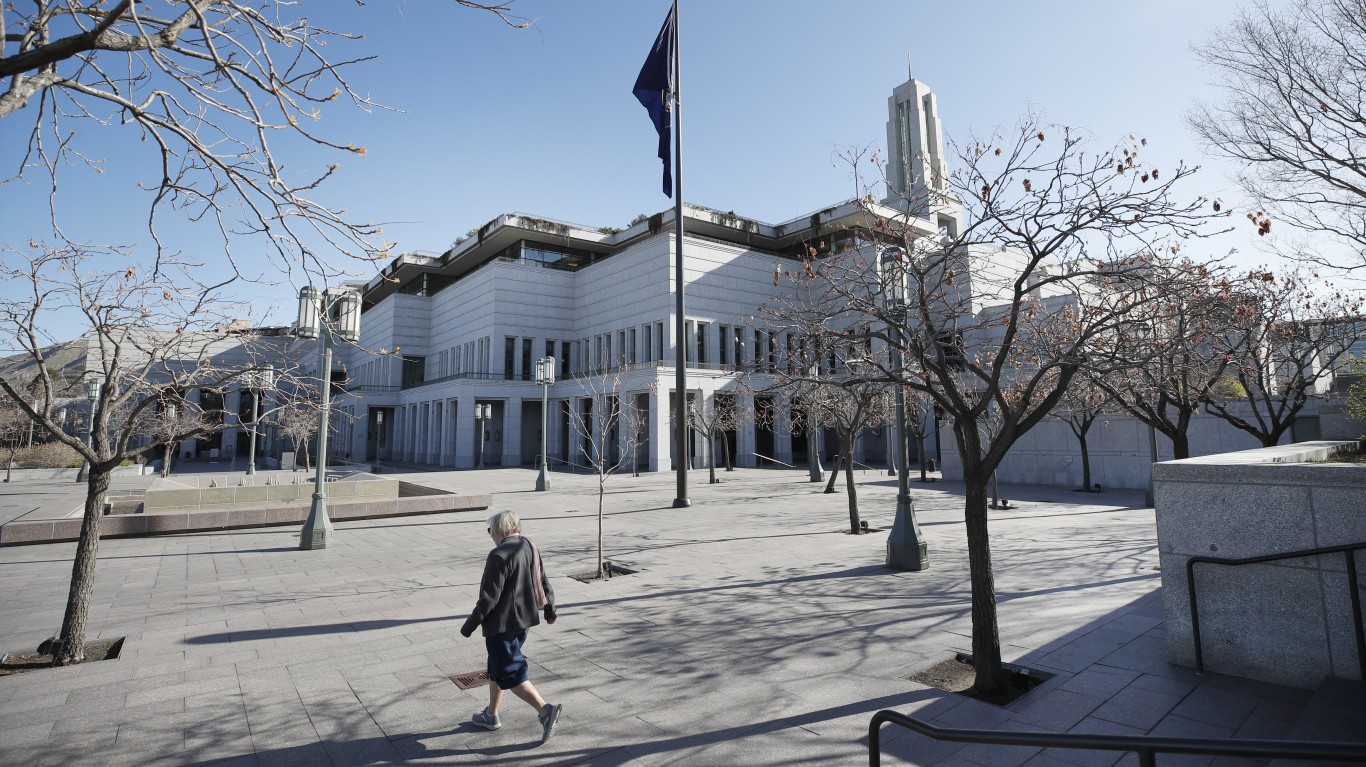
Utah
> Stay-at-home order: None
> Stay-at-home order lifted: N/A
> Quarantine for travelers (as of May 7): Mandatory for travelers from certain states
> School closure status: Closed for the academic year
> COVID-19 cases as of May 5, 2020: 5,449 (172.4 per 100,000 people — 22nd lowest)
> Projected unemployment rate, July 2020: 14.8% (10th lowest)
Utah Gov. Gary R. Herbert (R) never issued a statewide stay-at-home order but has issued other restrictions on nonessential businesses. The governor allowed in-restaurant dining as well as gyms and parks to reopen on May 1.
[in-text-ad-2]
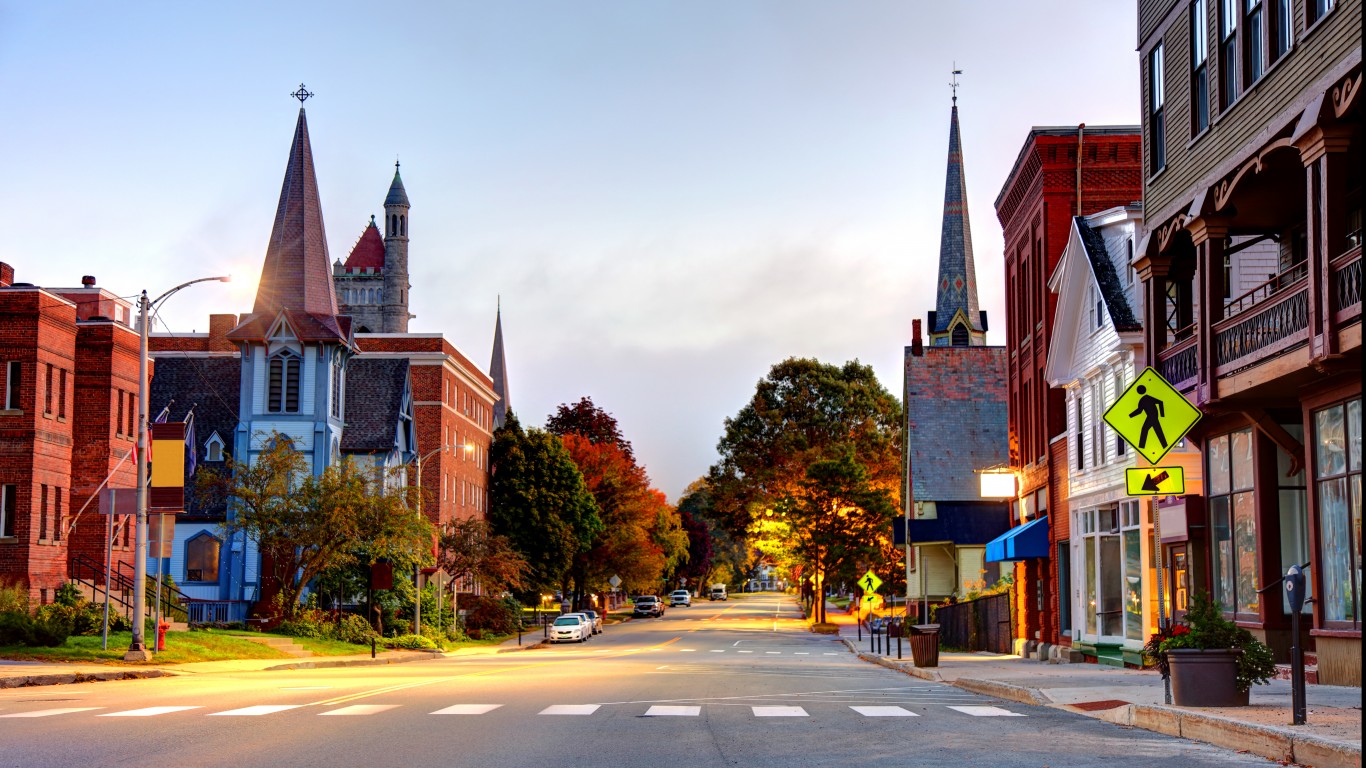
Vermont
> Stay-at-home order: Statewide; implemented March 25, 2020
> Stay-at-home order lifted: May 15, 2020
> Quarantine for travelers (as of May 7): Mandatory for all travelers
> School closure status: Closed for the academic year
> COVID-19 cases as of May 5, 2020: 907 (144.8 per 100,000 people — 18th lowest)
> Projected unemployment rate, July 2020: 15.0% (16th lowest)
Vermont is one of many Northeastern states to have a relatively restrictive stay-at-home timeline. Gov. Phil Scott (R) implemented the order on March 25 with the intention of lifting it on April 15. However, less than a week before the order was set to expire, Scott extended it until midnight on May 15.

Virginia
> Stay-at-home order: Statewide; implemented March 30, 2020
> Stay-at-home order lifted: June 10, 2020
> Quarantine for travelers (as of May 7): No mandatory restrictions
> School closure status: Closed for the academic year
> COVID-19 cases as of May 5, 2020: 19,357 (227.3 per 100,000 people — 19th highest)
> Projected unemployment rate, July 2020: 14.0% (3rd lowest)
Though Virginia did not impose a stay-at-home order until March 30, later than most states, the order will remain in effect long after many states will begin to take steps to returning to normalcy. The state’s stay-at-home order is not set to expire until June 10. However, residents were able to make nonemergency medical visits beginning on May 1.
[in-text-ad]

Washington
> Stay-at-home order: Statewide; implemented March 23, 2020
> Stay-at-home order lifted: May 31, 2020
> Quarantine for travelers (as of May 7): No mandatory restrictions
> School closure status: Closed for the academic year
> COVID-19 cases as of May 5, 2020: 15,462 (205.2 per 100,000 people — 20th highest)
> Projected unemployment rate, July 2020: 15.2% (21st lowest)
On March 23, Washington Gov. Jay Inslee (D) implemented a statewide stay-at-home order, which is now set to expire on May 31. However, most parks and recreation areas reopened on May 5.

West Virginia
> Stay-at-home order: Statewide; implemented March 24, 2020
> Stay-at-home order lifted: May 3, 2020
> Quarantine for travelers (as of May 7): Mandatory for travelers from certain states
> School closure status: Closed for the academic year
> COVID-19 cases as of May 5, 2020: 1,238 (68.6 per 100,000 people — 5th lowest)
> Projected unemployment rate, July 2020: 16.3% (10th highest)
West Virginia Gov. Jim Justice (R) recently introduced a multi-phased approach to reopening the state. Though the stay-at-home order was lifted statewide on May 3, Justice still encourages West Virginians to stay at home.
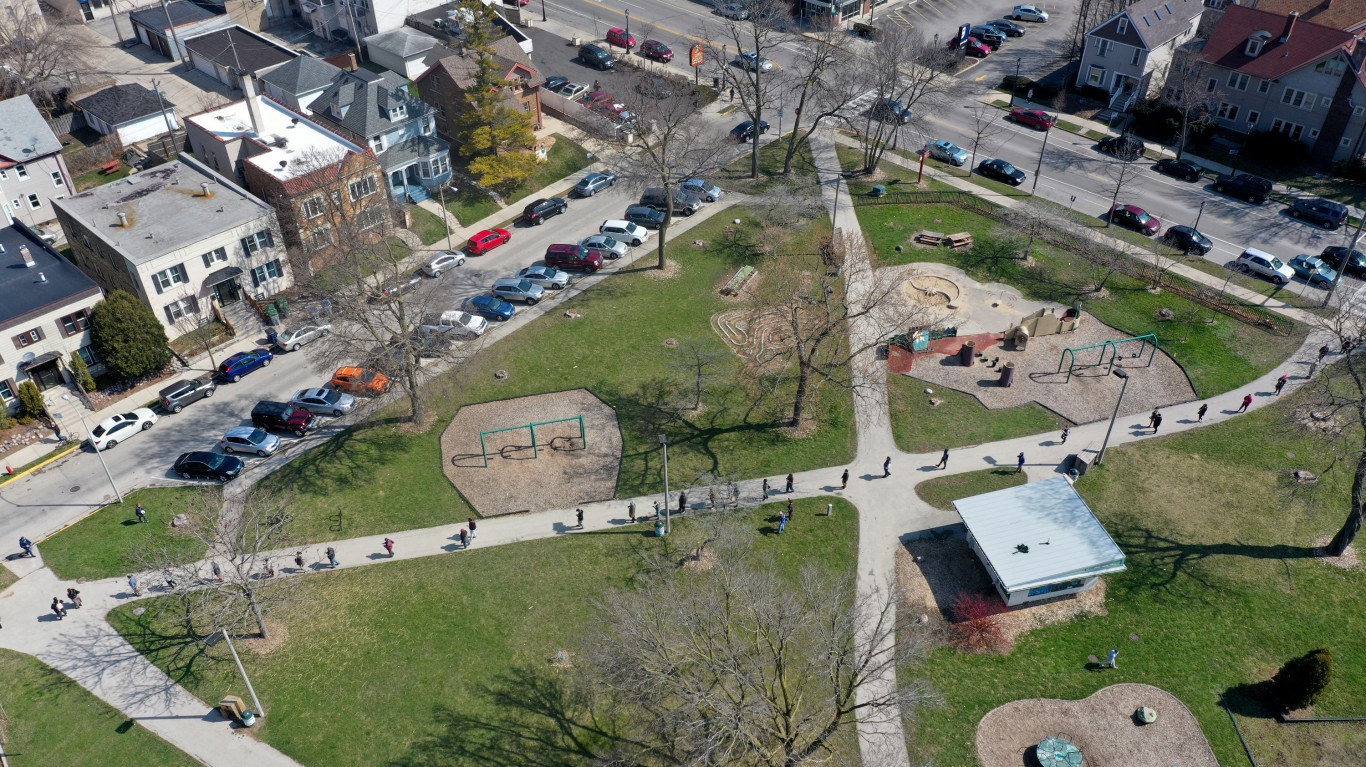
Wisconsin
> Stay-at-home order: Statewide; implemented March 25, 2020
> Stay-at-home order lifted: May 26, 2020
> Quarantine for travelers (as of May 7): No mandatory restrictions
> School closure status: Closed for the academic year
> COVID-19 cases as of May 5, 2020: 8,566 (147.3 per 100,000 people — 20th lowest)
> Projected unemployment rate, July 2020: 15.6% (19th highest)
Though outdoor recreation, like golf and boating, is permitted, the state’s stay-at-home order will remain in effect in Wisconsin until it expires on May 26.
[in-text-ad-2]

Wyoming
> Stay-at-home order: None
> Stay-at-home order lifted: N/A
> Quarantine for travelers (as of May 7): Mandatory for all travelers
> School closure status: Temporarily closed
> COVID-19 cases as of May 5, 2020: 452 (78.2 per 100,000 people — 6th lowest)
> Projected unemployment rate, July 2020: 16.3% (10th highest)
Wyoming Gov. Mark Gordon (R) is one of only a handful of state leaders to not issue a stay-at-home order. Gordon has, however, closed certain nonessential businesses and issued a directive for out-of-state visitors to quarantine for two weeks. Gordon began easing restrictions on May 1.
Credit card companies are pulling out all the stops, with the issuers are offering insane travel rewards and perks.
We’re talking huge sign-up bonuses, points on every purchase, and benefits like lounge access, travel credits, and free hotel nights. For travelers, these rewards can add up to thousands of dollars in flights, upgrades, and luxury experiences every year.
It’s like getting paid to travel — and it’s available to qualified borrowers who know where to look.
We’ve rounded up some of the best travel credit cards on the market. Click here to see the list. Don’t miss these offers — they won’t be this good forever.
Thank you for reading! Have some feedback for us?
Contact the 24/7 Wall St. editorial team.